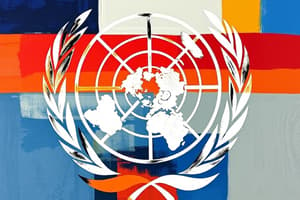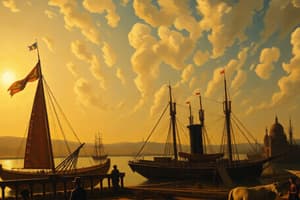Podcast
Questions and Answers
Which of the following was the first recognizable metal coin system that appeared in China?
Which of the following was the first recognizable metal coin system that appeared in China?
- Bimetallic System
- Barter System
- Metal Coins (correct)
- Minting Process
Which of the following is NOT a use for recycled banknotes?
Which of the following is NOT a use for recycled banknotes?
- Plant pots
- Stock market investments (correct)
- Building components
- Garden furniture
The Cowries became the most common form of currency in the Philippines during the Spanish Era.
The Cowries became the most common form of currency in the Philippines during the Spanish Era.
True (A)
Mobile payments have increased their share in total monthly retail payments in the Philippines.
Mobile payments have increased their share in total monthly retail payments in the Philippines.
What is the process of creating a coin by stamping metal called?
What is the process of creating a coin by stamping metal called?
What is the term used for a digital representation of fiat currency stored in digital wallets?
What is the term used for a digital representation of fiat currency stored in digital wallets?
The world's first bimetallic monetary system used both gold and ______ as currency.
The world's first bimetallic monetary system used both gold and ______ as currency.
Cryptocurrency is digital money that operates on a decentralized network based on __________ technology.
Cryptocurrency is digital money that operates on a decentralized network based on __________ technology.
Match the following eras in Philippine currency history with their corresponding characteristics:
Match the following eras in Philippine currency history with their corresponding characteristics:
Match the following types of currency with their definitions:
Match the following types of currency with their definitions:
What term is used to denote currency that is valid for the payment of debts?
What term is used to denote currency that is valid for the payment of debts?
What percentage of monthly digital payment volume in the Philippines was contributed by merchant payments in 2023?
What percentage of monthly digital payment volume in the Philippines was contributed by merchant payments in 2023?
Name one of the first paper currencies issued by European colonial governments.
Name one of the first paper currencies issued by European colonial governments.
Virtual currencies are typically issued and controlled by a central authority.
Virtual currencies are typically issued and controlled by a central authority.
The Filipinization of Republic coins and notes began in the 1970s.
The Filipinization of Republic coins and notes began in the 1970s.
Mobile wallets facilitate cashless transactions by enabling users to store __________ and make payments.
Mobile wallets facilitate cashless transactions by enabling users to store __________ and make payments.
Which of the following was the first country to use coins?
Which of the following was the first country to use coins?
Bartering allows for the exchange of goods and services without the use of money.
Bartering allows for the exchange of goods and services without the use of money.
What is the most valuable item used in trade during ancient times?
What is the most valuable item used in trade during ancient times?
Money serves as a _____________, providing a common measure of value for comparing goods and services.
Money serves as a _____________, providing a common measure of value for comparing goods and services.
What is not a disadvantage of bartering?
What is not a disadvantage of bartering?
Match the following items with their historical significance:
Match the following items with their historical significance:
The process of _____________ is crucial in the production of coins in economies.
The process of _____________ is crucial in the production of coins in economies.
Digital currencies are not considered a form of money.
Digital currencies are not considered a form of money.
Flashcards
Mobile Payments
Mobile Payments
Using a mobile device to make payments for goods or services.
Digital Wallet
Digital Wallet
An app that securely stores payment info on a mobile device or online.
Virtual Currency
Virtual Currency
Digital currency accepted within a community without physical form.
Cryptocurrency
Cryptocurrency
Signup and view all the flashcards
Fiat Currency
Fiat Currency
Signup and view all the flashcards
E-money
E-money
Signup and view all the flashcards
Banknote Recycling
Banknote Recycling
Signup and view all the flashcards
Digital Payments Growth (Philippines)
Digital Payments Growth (Philippines)
Signup and view all the flashcards
First recognizable metal coins
First recognizable metal coins
Signup and view all the flashcards
Bimetallic monetary system
Bimetallic monetary system
Signup and view all the flashcards
Paper money in China
Paper money in China
Signup and view all the flashcards
Legal tender
Legal tender
Signup and view all the flashcards
Minting
Minting
Signup and view all the flashcards
Philippine currency history
Philippine currency history
Signup and view all the flashcards
Cowries
Cowries
Signup and view all the flashcards
Central Bank of the Philippines
Central Bank of the Philippines
Signup and view all the flashcards
Barter System
Barter System
Signup and view all the flashcards
Disadvantages of Barter
Disadvantages of Barter
Signup and view all the flashcards
Evolution of Barter
Evolution of Barter
Signup and view all the flashcards
Valuable Items in Ancient Times
Valuable Items in Ancient Times
Signup and view all the flashcards
Money's Functions
Money's Functions
Signup and view all the flashcards
Origin of Coins
Origin of Coins
Signup and view all the flashcards
Limitations of Barter
Limitations of Barter
Signup and view all the flashcards
Study Notes
World Trade Organization (WTO)
- WTO is the only global international organization dealing with the rules of trade between nations.
- Its headquarters are located in Geneva, Switzerland.
- It has 164 members and 22 countries are in the process of joining.
- Major decisions are made by member governments through ministers, ambassadors, or delegates.
- WTO's predecessor was the General Agreement on Tariffs and Trade (GATT).
- GATT was established in 1947 after World War II.
- GATT was part of a larger effort for international economic cooperation with the World Bank and International Monetary Fund.
Goal of WTO
- The WTO aims to ensure smooth, predictable, and free flow of trade.
- Its goal is to aid producers, exporters, and importers.
Roles of WTO
- Operates a global system of trade rules.
- Acts as a forum for negotiating trade agreements.
- Resolves trade disputes between members.
- Supports the needs of developing countries.
Director General of WTO
- Ngozi Okonjo-Iweala is the first woman and first African director general.
- Her term ends August 31, 2025.
Main Theories
Classical/Country-Based Theory
- Focuses on the country as the primary unit of analysis.
- Explains trade patterns based on national characteristics like resources, productivity or comparative advantage.
- Examples: Mercantilism, Absolute Advantage (Adam Smith), Comparative Advantage (David Ricardo), and Heckscher-Ohlin Theory.
Firm-Based/Company-Based Theory
- Emphasizes the role of individual companies in international trade.
- Highlights competitive strategies, branding, customer loyalty, and innovation.
- Examples: Product Life Cycle Theory, New Trade Theory, and Strategic Trade Theory.
Adam Smith and David Ricardo
- Their work is foundational in economics, exploring wealth creation, division of labor, free markets, and government's role in the economy.
Theory of Free Trade
- Supports unrestricted international trade without tariffs, quotas, or subsidies.
- Advocates that open markets lead to efficient resource allocation, benefiting all participating nations.
International Trade History
- Trade is a very old occupation in human history.
- Roman empire development occurred in the 15th to 18th century with the improvements in navigation and the discovery of new trade routes.
- Examples of important historical figures/events related to trade: Christopher Columbus, Vasco Da Gama, Bartolemeu Dias, the Silk Road.
Theory of Price-Specie Flow Mechanism
- Created in the mid-18th century by David Hume.
- Explains how international trade imbalances self-correct under a gold standard through gold flows affecting money supply, price levels, and trade balances.
Trade Surplus
- Occurs when a country's exports exceed its imports.
- Indicates a positive balance in a nation's trade account.
Division of Labor
- Separates a work process into tasks performed by different people/groups.
- Increases productivity and specialization.
Industrial Capitalism
- A phase of capitalism where industries dominate production.
- Transition from agricultural economies to industrialized production.
- Characterized by private ownership of production, competitive markets, and profit-seeking.
Mercantilism
- Emphasizes maintaining a positive trade balance.
- Focuses on maximizing exports while minimizing imports.
Comparative Advantage
- Emphasizes a country's ability to produce a particular good at a lower opportunity cost compared to other countries.
Barter
- Direct exchange of goods and services.
- Used before the adoption of monetary systems.
- Disadvantages include difficulty finding suitable partners, valuing goods, and preserving perishables.
Fiat Currency/Cash
- Currency issued and printed by a country's central bank.
- Fully backed by the government and accepted as payment for transactions.
E-Money
- Digital representation of fiat currency.
- Stored in digital wallets and used for payments.
Debit Cards
- Allow access to funds directly from a bank account.
- Transactions are directly deducted from the account balance.
New Generation Currency (NGC)
- Enhanced banknotes with improved security, ecological concerns, and user-friendliness (e.g., made of polymer).
Mobile Payments
- Transactions using portable electronic devices.
- Increase due to increased convenience and adoption of technology.
Virtual Currency (Cryptocurrency)
- Digital form of currency using cryptography for security and transactions on a decentralized network (e.g., blockchain).
- Often not controlled by a central authority.
Studying That Suits You
Use AI to generate personalized quizzes and flashcards to suit your learning preferences.




